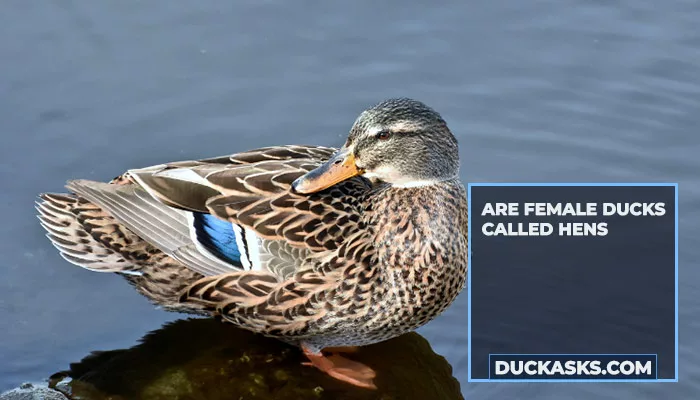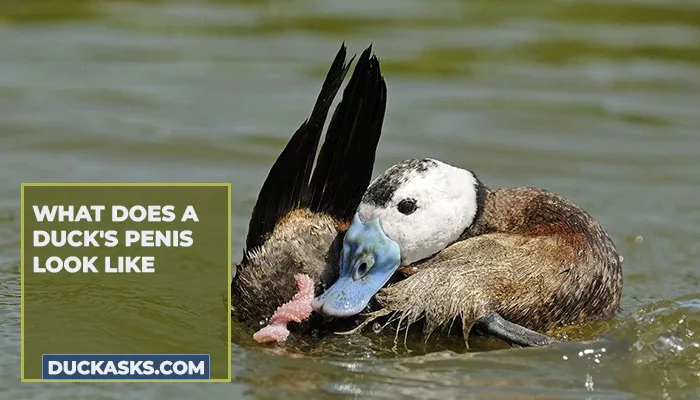Why Do Ducks Lay Down In The Snow?
Ducks tend to make seasonal movements as part of their survival instinct. As part of their instinct, they often lay down in the snow. Some of you might think they just take a rest by lying. However, the answer is no.
Then why do ducks lay down in the snow? Ducks lay down in the snow to conserve energy and retain body heat. Their insulating fat layer, overlapping waterproof feathers, and ability to control leg blood flow prevent heat loss.
Sheltering from the wind and tucking their feet under feathers helps ducks keep warm when lying down.
Reducing exposed surface area and activity further reduces energy use and heat loss to the snow. Laying down allows ducks to stay warm in frigid conditions.
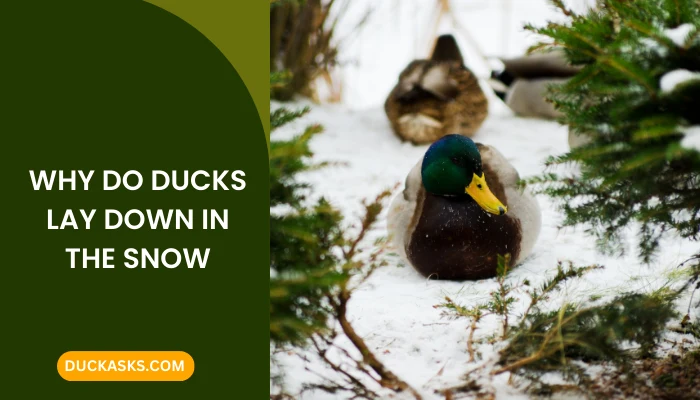
If you want to know more about how laying down helps ducks, then keep reading.
Looking for more articles about fun fact:
The Reason Ducks Are Able to Lay or Sit on the Snow
The study by Kilgore and Schmidt-Nielsen revealed that mallard ducks have a specialized counter-current heat exchange system in their legs and feet that prevents heat loss through their feet.
This allows them to swim in icy water without losing much body heat through their feet and legs. This same counter-current heat exchange system is why ducks are able to lie down in the snow without freezing.
When ducks lay down and tuck their feet under their belly feathers, the heat exchange system keeps their feet sufficiently cool to prevent tissue damage while also ensuring enough warm blood flows to provide oxygen and nutrients.
So, while ducks lose only about 5% of body heat through their feet when in freezing water, this heat exchange system continues to work when they are on land and lying down. It prevents the feet from freezing in the snow.
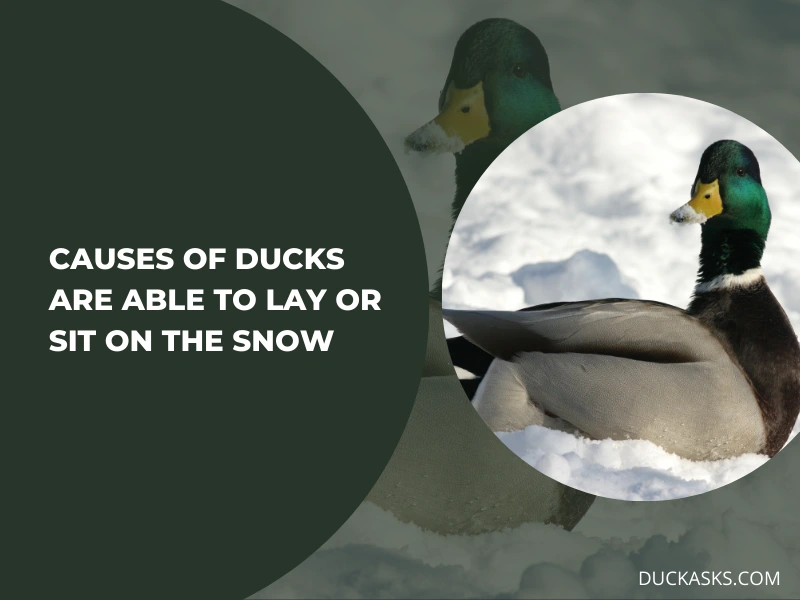
Additionally, when ducks lay down, they reduce the surface area exposed to the cold air. Most heat is lost through the head and body, which are exposed.
But by sheltering from the wind and trapping heat under their insulating feathers, ducks can retain body heat even in frigid conditions.
These specialized circulation adaptations that allow ducks to swim in icy water also facilitate their ability to rest on the snow without freezing or losing excessive body heat.
The combination of circulatory adjustments and feather insulation enables ducks to lie down in snowy environments.
What Happens When Ducks Come into Contact with Snow
Duck bodies possess numerous adaptations that allow them to not just survive but thrive in frigid environments. A key factor is their insulating and waterproof plumage.
The outer layer of feathers is coated in oil, which makes them impervious to water. Beneath this, a thick layer of down feathers traps air and creates insulation from the cold.
By fluffing their feathers, ducks can increase the amount of warm air held close to their bodies. Ducks also have an ample layer of fat beneath their skin that adds insulation and protects them from freezing temperatures.

This subcutaneous fat is especially thick around the belly and tail. Their legs contain a specialized circulatory system that minimizes heat loss through their feet.
Arteries transfer heat to veins through a counter-current exchange that keeps their feet sufficiently cool to prevent tissue damage while also adequately warm.
Behaviors like hunkering down out of the wind, tucking their feet into their feathers, and huddling together further aid ducks in retaining heat in harsh winter conditions.
Thanks to these numerous adaptations, ducks are impressively tough against the cold and snow.
Their innate biological mechanisms allow them to thrive where most other creatures would perish when faced with frigid temperatures and icy conditions. Ducks are uniquely equipped to handle almost any winter environment.
Are Ducks Hardy Waterfowl?
Ducks are one tough species of planet Earth; they have specialized circulatory adaptation that enables them to conserve heat in frigid environments. They are mechanisms to cope with the most extreme weather conditions. Have a look –
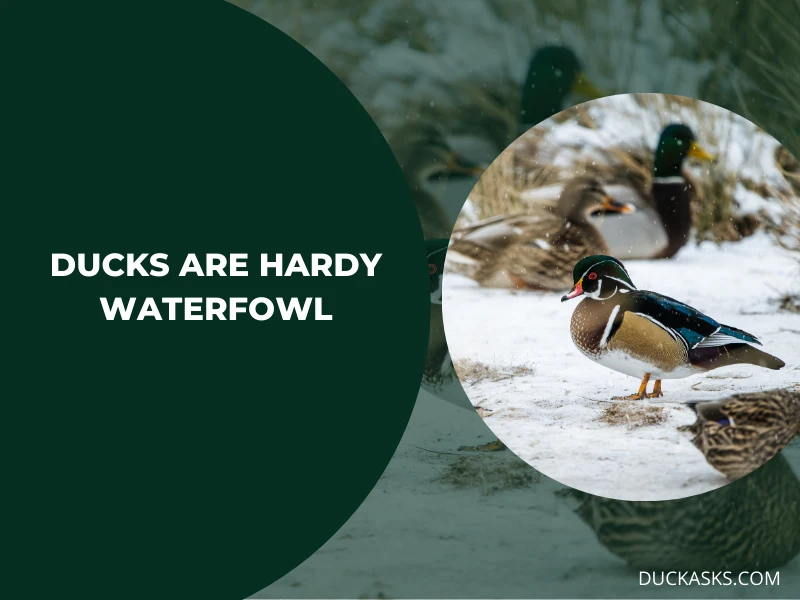
Fat Layer Insulates
Ducks have a thick layer of fat under their skin that provides insulation against the cold snow. This fat layer traps body heat.
Feathers Trap Air
Their outer feathers are coated in oil that repels water. The soft inner down feathers trap air, which acts as insulation.
Tuck Feet into Feathers
Ducks can tuck their feet under their belly feathers when sitting in the snow. This reduces the surface area exposed to the cold.
Vasoconstriction
Ducks can constrict blood vessels in their legs and feet to reduce blood flow and minimize heat loss.
Counter-Current Heat Exchange
The network of blood vessels in ducks’ legs transfers heat from arterial blood to venous blood, preventing heat loss through the feet while keeping the core warm.
The arteries carry warm blood from the duck’s core down to the feet. The veins carry cooler blood back up from the feet towards the body.
Here is how the counter-current heat exchange works –
- As the warm arterial blood flows past the cooler venous blood, heat is exchanged between the two. The warm blood gives off some of its heat to the cooler venous blood.
- This means by the time the arterial blood reaches the duck’s feet, it has cooled down. Less heat makes it to the extremities to be lost to the environment.
- Meanwhile, the venous blood gains heat from the arterial blood, so it returns to the duck’s body core warmer than when it left the feet.
- Because the arterial and venous vessels are intertwined, the heat transfer is very efficient. It’s like a radiator or heat exchanger.
- Only about 5% of body heat is lost through the feet. The remaining 95% is retained as the blood circulates back up the legs.
- This prevents the duck’s feet from freezing while also conserving overall body heat. The feet stay cool but not frozen.
So, the counter-current exchange system recaptures heat from the blood leaving the extremities and returns it back to the body. This maintains warm temperatures in the core while preventing tissue damage in the feet.
Shelter from Wind
Ducks rest in sheltered areas like vegetation, which blocks the wind and reduces convective heat loss.
Huddle Together
Groups of ducks will huddle together to share body heat and reduce the surface area exposed to the cold.
Fluff Feathers
Fluffing their feathers creates more trapped air to act as insulation. It’s not only for showing that they’re beautiful.
Reduce Activity
Laying down and resting reduces muscle activity, which lowers metabolic heat production. This conserves energy.
What Are the Benefits for Ducks to Lay Down in the Snow?
There is little benefit for ducks to lay down in snow. Have a look –

1. Warmth
Ducks have a system that helps them to regulate feet temperature. It prevents any kind of frostbite and even heat loss. However, by laying down on snow, they can cover their feet and body with insulating feathers.
Also, snow can insulate the ground, making ducks use less body heat.
2. Energy
In winter, ducks require more food to maintain metabolism and temperature. Laying down in the snow helps to save energy and reduce body activity.
3. Enjoy the Winter
You would be surprised that ducks sometimes lie in the snow to enjoy the weather. They are playful animals, which keeps their minds stress-free and increases reproduction capability.
4. Camouflage
Snow helps ducks hide from predators. So, when they lay down, predators can’t spot them easily.
5. Hydration
When other water sources are frozen, ducks can melt snow to drink it as a water source. Sometimes, snow even reveals food sources such as insects.
Do All Types of Ducks Lie Down in the Snow?
All types of ducks do not lie down in the snow. Different duck species have different adaptations and habits. Hottentot teal and Muscovy are warm-weather ducks, and these can’t lie on the snow.

Also, duck species who live on aquatic food sources do not like the snow at all.
Here are some ducks that do lie down on the snow –
| Species Name | Reasons |
|---|---|
| Common Eider | These are sea ducks that you’ll find in the northern sides. Because they have insulated thick feathers, they lie on the snow. |
| Harlequin | Harlequin ducks are well-adapted to snow and fast-flowing rivers. They too have insulated feathers which gives them lie on snow. |
| King Eider | Just like common eiders they are seen on the northern side and great with snow. |
| Barrow’s Goldeneye | These ducks inhabit lakes and snowy areas of North America. So, they have no problem with snow. |
| Bufflehead | Buffleheads that are known for black an white plumage are great in snow. Their wings provide excellent insulation capacity. |
| Northern Pintail | Northern pintails can lie on snow and tolerate winter to an extent. |
Can Ducks Sleep in the Snow?
Ducks can sleep in the snow. But that doesn’t mean they always should. Extreme snow can lead to death, so ducks sleep on snow if they have no choice.
Ducks naturally have insulating feathers. These feathers help them to keep their body warm. Also, it provides a thick layer of warmth. So, it helps when ducks sleep in the snow, the feathers provide insulation and trap layers of air.
As the air traps close to its body, it helps to maintain body temperature even if it sleeps in the snow. But insulation doesn’t work if the temperature is below 27 degrees.
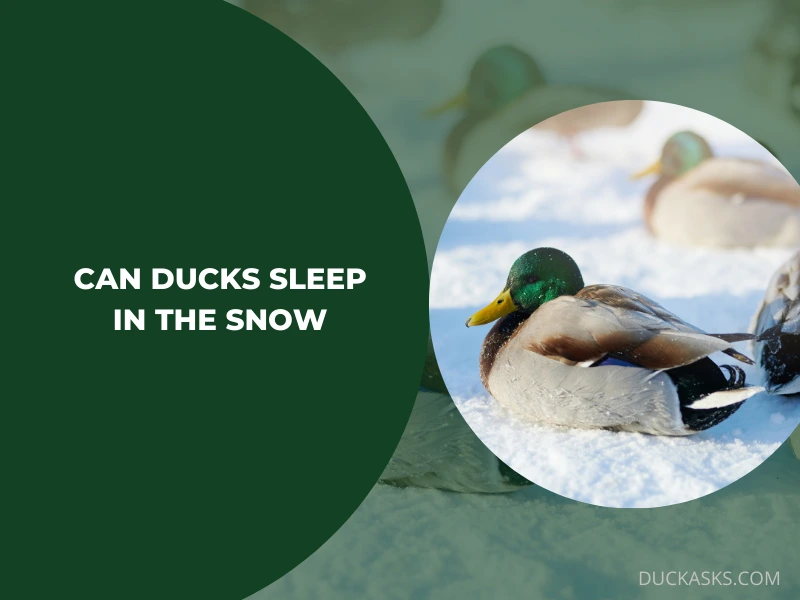
That’s why if you’re petting ducks, it’s better not to make them sleep in the snow.
Did you know that ducks have a circulatory system that keeps their feet and legs warm?
Ducks can sleep in the slow because of this system that allows warmth and avoids cold discomfort. Also, they adapt to the snow environment because of the circulatory system.
Ducks don’t directly sleep over snow. They look for reeds, bushes, and even hanging branches to protect themselves from frostbite.
When it’s winter, I always notice ducks sleep in groups. That’s because sleeping in groups creates heat. As a result, they can sleep in the snow.
Also, they tuck bills under the bills so they don’t lose heat loss if they choose to sleep in the snow.
How Long Do Ducks Usually Stay Lying Down in the Snow?
Unfortunately, there is no accurate answer. Ducks may lie down in the snow for many reasons. Extended periods laying in snow can cause frostbite.
The maximum time is an hour. If the duck lays down in the snow for over an hour, it indicates it is sick.
Do Ducks Lay Eggs During the Winter?
Yes, ducks do lay eggs during winter or in the snow. But some factors must be considered. For example, ducks breed, weather conditions and temperature severely impact the duck’s reproduction pattern.
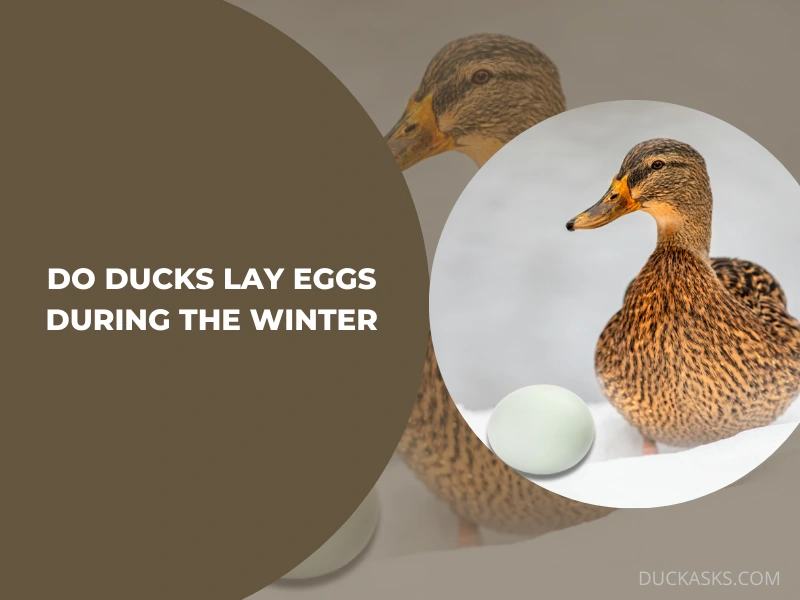
Breed
Not all ducks lay eggs in snowy weather. Different ducks have different winter egg production tendencies.
Most of the species do not lay eggs at a regular rate in snow. Ducks species like Indian Runner Khaki lay eggs in winter but at a reduced rate than regular.
Moreover, hatching eggs can be complicated and risky in snow.
Daylight
Due to shorter daylight, most ducks can avoid laying eggs in winter. As we all know, winter days are short snowy hours, and ducks are active during the daytime. So, laying eggs can slow down during winter in some cases.
Cold Temperature
Ducks do not take part in reproduction in extreme environments. If the snow is excessive, then it may decrease the egg production. However, if the ducks are sheltered, that might not affect the lying situation.
Also, duck eggs are usually prone to snow. So, the mother duck has to provide extra warmth through incubation with fewer breaks. Most of the time, ducks reduce the time of the eggs stay in plain snow.
Because if the temperature goes below 10 degrees Celsius, the egg can die.
Nutrition
For extreme snowfall, ducks need extra nutrients and food sources. They won’t lay eggs if insufficient food or any deficiencies support their egg production. Also, there must be enough warm water sources to prevent dehydration.
Sometimes, bathing in cold water can impact egg production.
Age
Young ducks avoid laying eggs in the snow because they can’t provide enough warmth. However, as they age, they become consistent in increasing egg production.
Shelter
Pet ducks might lay eggs on snow if they are provided with a safe environment and space. Usually, ducks always lay eggs in summer, spring, and sometimes fall.
Frequently Asked Questions
01. At what temperature do ducks get frostbite?
Ducks can get frostbite below 20°F, but susceptibility varies by breed and region. Muscovy ducks tend to get facial frostbite more readily.
02. Do ducks stop laying in winter?
Ducks halt or diminish producing eggs when seasons shift from warm to cold. Laying peaks amid spring through summer, then lessens or ceases in autumn and winter.
03. Where do ducks go at night in the winter?
After dark in winter, waterfowl repose in protected areas to retain warmth and reduce energy expenditure. Rotating roost locations optimizes energy savings in diverse conditions.
Conclusion
Ducks can lay down in the snow to preserve heat and, in some cases, to rest. However, they can stay in snow up to 20-degree temperature. If it’s below that, they’ll get frostbite.
I hope this article helped you, please stay connected with our Facebook, Twitter, and Pinterest.
References:
- https://www.sciencedirect.com/science/article/abs/pii/S0048969722027681
- https://academic.oup.com/jhered/article-abstract/52/5/237/816819




